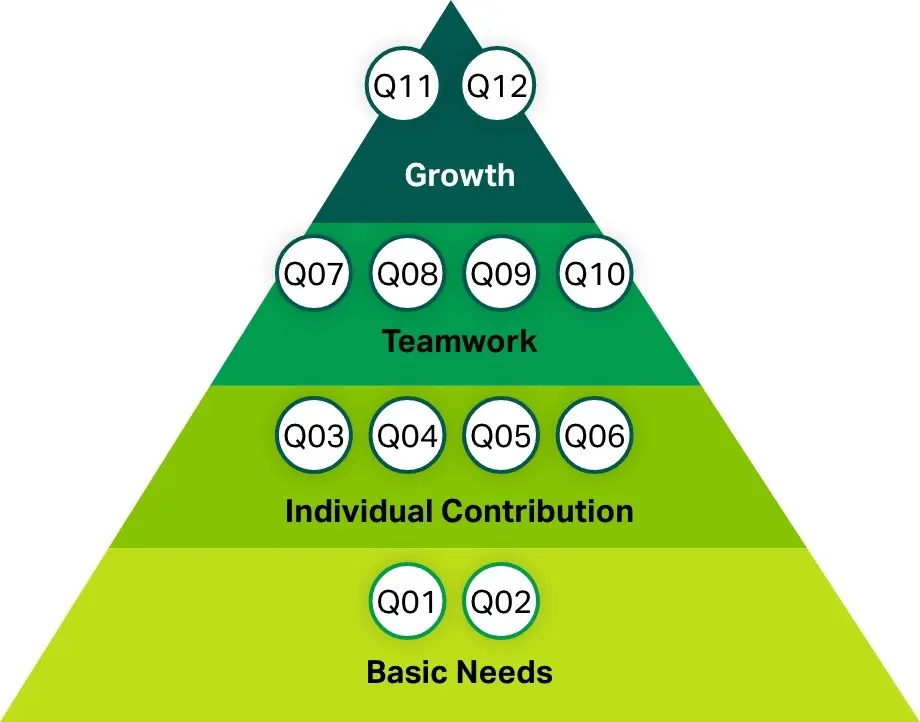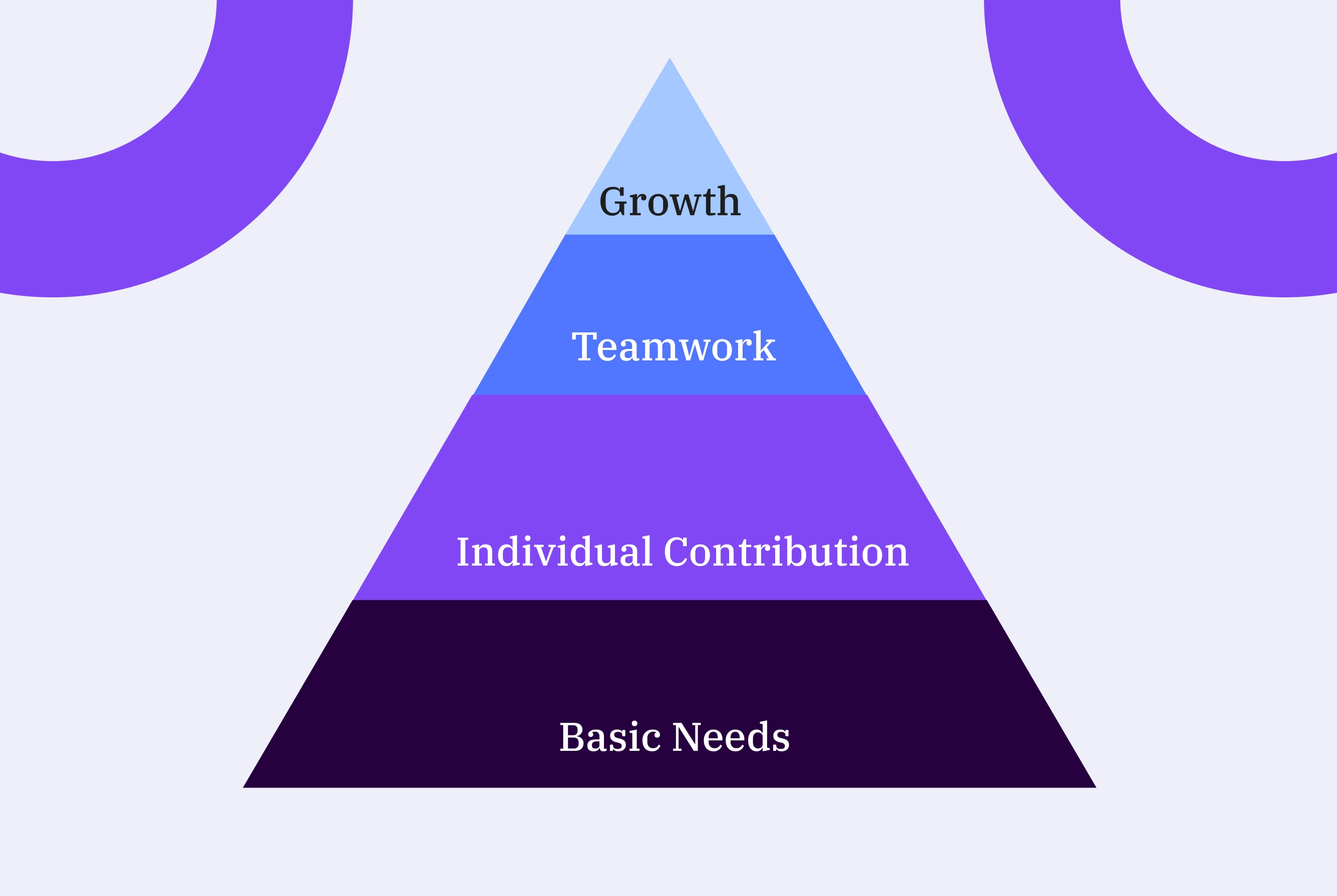Table content
In any organization, whether it is a corporate office, small business, or volunteer group, a vital component of success is understanding how employees are feeling in the workplace. One of the best ways to gauge their satisfaction and hear their thoughts is through an employee engagement survey.
Though there are many ways to approach this type of survey, one of the most trusted tools for measuring it is the Gallup Q12.
What is Gallup Q12?
Gallup Q12 is a scientifically validated survey tool - developed by workplace consulting and research firm Gallup - to assess employee engagement within organizations. It consists of 12 specific questions that capture employee perceptions of their workplace environment, focusing on their needs, experiences, and emotional connections to their work.
The Gallup Q12 measures various dimensions of employee engagement, including job satisfaction, commitment, and overall morale. By gathering feedback on these areas, organizations can pinpoint strengths and weaknesses in their workplace culture, ultimately driving improvements and enhancing employee retention.
The Gallup Q12 Pyramid, Explained
Before jumping into how to craft a robust survey using the Gallup 12 philosophy, it’s important to understand the Gallup Q12 pyramid.

Image source: https://www.gallup.com/q12/
This illustrates the hierarchical nature of employee engagement. At its base, individual needs—such as basic job satisfaction and clarity of expectations—must be met. As these foundational elements are addressed, higher levels of engagement, like teamwork and belonging, can flourish. Understanding this pyramid helps organizations identify where they need to focus their efforts for maximum impact.
The Gallup Q12 Questions
When following the Gallup Q12 ethos, your survey will include targeted questions designed to gauge different elements of employee sentiment. These questions cover a range of topics, including:
- Clarity of expectations
- Opportunities to do what employees do best
- Recognition and praise
- Opportunities for personal development
- Sense of belonging in the workplace
Each question is carefully crafted to elicit insights that can inform management strategies and enhance employee engagement. For instance, questions regarding recognition aim to understand if employees feel valued for their contributions. By analyzing responses, organizations can better understand their workforce and implement effective change.
Conducting the Gallup Q12 Survey
To conduct the Gallup Q12 survey most effectively, organizations should ensure anonymity. With LimeSurvey’s open-source platform and customizable survey options, it’s quick and simple to enable anonymous responses, which goes a long way in encouraging participants to provide candid responses.
Timing is also crucial—conducting the survey on a regular basis helps organizations track engagement trends over time and provides deeper insights into employee engagement, the efficacy of changes, and what the business needs to fine-tune to ensure staff are satisfied and growing.
How to Interpret Gallup Q12 Results
Interpreting Gallup Q12 results involves analyzing response patterns and identifying key areas for improvement. High scores in specific areas may indicate strengths to build upon, while lower scores reveal opportunities for development.
For instance, imagine a company where the Gallup Q12 survey results show high scores in areas like “I have the materials and equipment I need to do my work right” and “My supervisor, or someone at work, seems to care about me as a person.” These strengths can be leveraged to enhance employee engagement and morale further. However, if the scores are low in areas such as “I have a best friend at work” or “In the last six months, someone at work has talked to me about my progress,” it highlights a need for team-building initiatives and more regular feedback mechanisms.
To effectively measure these factors, LimeSurvey provides comprehensive tools that allow organizations to create tailored surveys. Features include customizable question types and branching logic, making it easy to dive into specific areas of interest. Plus, all results can be easily exported to Excel for in-depth analysis and reporting, enabling teams to track progress over time and develop targeted action plans based on data-driven insights.
Additionally, Gallup provides benchmarks based on survey responses from various industries and organizations. These benchmarks allow companies to compare their engagement levels against similar organizations.
Gallup Q12 Meta-Analysis Insights
Understanding where you stand can motivate improvements and drive competitive advantages, and allows you to conduct meta-analysis, if needed.
Through a meta-analysis of Gallup Q12 data, organizations can glean significant insights about employee engagement and its correlation with business outcomes. Enterprises with high engagement levels experience lower turnover rates, increased productivity, and higher customer satisfaction.
Here are some key insights organizations may receive from meta-analyses of Gallup Q12 data:
- Engagement Drives Performance: Higher levels of employee engagement, as indicated by Q12 scores, correlate strongly with improved productivity, customer satisfaction, and profitability.
- Retention and Turnover: Organizations with higher Q12 scores tend to experience lower turnover rates. Engaged employees are less likely to leave their jobs, which can significantly reduce recruitment and training costs.
- Team Dynamics: The Q12 emphasizes the importance of team relationships. Employees who feel connected to their coworkers and managers are more engaged and productive.
- Recognition and Feedback: Regular recognition and constructive feedback are crucial for employee engagement. The Q12 highlights the need for managers to provide ongoing support and acknowledgement of accomplishments.
- Individual Development: Employees who see opportunities for personal growth and development in their roles are more likely to be engaged. Organizations that invest in training and career advancement tend to have higher Q12 scores.
- Clear Expectations: Having clearly defined roles and expectations is vital for employee engagement. When employees know what is expected of them, they are more likely to perform at their best.
- Alignment with Company Mission: Employees who understand and align with the company’s mission and values are generally more engaged. This alignment fosters a sense of purpose and belonging.
- Work-Life Balance: The Q12 also touches on the importance of work-life balance. Employees who feel they can manage their work and personal lives effectively are typically more satisfied and engaged.
Gallup Q12 is a powerful tool for measuring and enhancing employee engagement. By understanding its components and how you can effectively leverage both this questionnaire framework and LimeSurvey’s user-friendly survey tools, organizations can derive actionable insights that create a more engaged workforce—leading to greater overall success.
Create GallupQ12 Surveys with LimeSurvey
With LimeSurvey, organizations can create impactful employee engagement surveys that guarantee anonymity, provide real-time results, and useful measurement tools that make it easy to export findings so that you can derive the insights you need faster.




